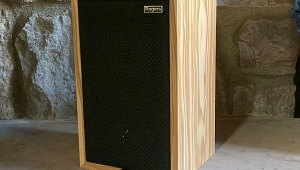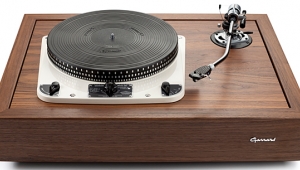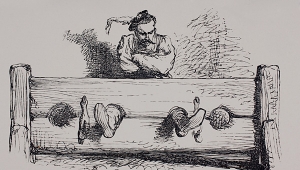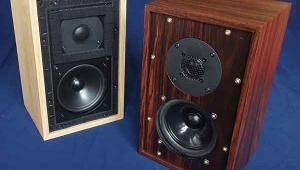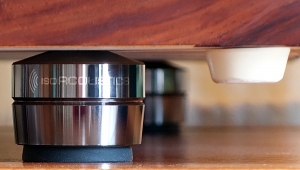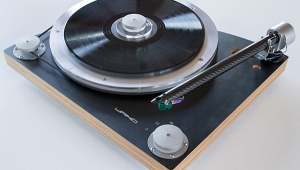| Columns Retired Columns & Blogs |
Listening #77
Faith is the substance of things hoped for, the evidence of things unseen.—Hebrews 11:1
Footnote 1: Keith Monks Audio Works, Units 3–9 Westcliff Park, Ventnore, Isle of Wight PO38 2YR, England. US Distributor: Keith Monks American Audio Works, 181 Prynnwood Road, Longmeadow, MA 01106-272. Tel: (413) 754-3313. Web: www.keithmonks-rcm.co.uk.
What could possibly sound worse than an unclean record? A record that was ruined by cleaning—whether through bad luck, carelessness, or a poorly chosen cleaner.
There are two or three such discs in my own collection. One is a British compilation LP by the Move, Shines On, which I bought in 1986 just so I could have the singles "Tonight," "Do Ya," "Chinatown," and "California Man." After listening to the record once or twice, I decided to "improve" it by washing it on my pricey, audiophile-grade, wet-wash/vacuum-dry record-cleaning machine. Afterward, I sat transfixed with horror: Some of the music was now overlaid with a squiggly, screechy noise that sounded as if a senseless new groove had been gouged atop the old one.

That might be what happened: Minutes later, rinsing the machine's velvet-lipped pickup tube at the kitchen sink, I thought I felt a few traces of grit lodged in the nap. Could that have done it? I supposed so. Then and there, every part of my record-cleaning machine that came in contact with a record got a once-over with distilled water, after which I machine-washed that Move album again. The problem remained—as it would to this day, of course—but at least it got no worse.
Confession No.1: Ever since that day, I've been a little bit wary of record-cleaning machines (which I'll refer to as RCMs from here on) that vacuum dry the surface of a record by means of a nappy slot. I also have the impression that the slot approach is less effective than other, more focused vacuum apertures.
But that's all it is: an impression. It shares brain space with my impression that using a limp brush moistened with solvent to clean a stylus tip is like using a feather duster to clean a windshield after driving through a cloud of grasshoppers on a hot day. And my impression that the "bottom" of a record groove isn't likely to be any more or less damaged than the rest of it. And my impression that, whatever real, audible differences might be effected by record preservatives or demagnetizers, it probably isn't because the record has been preserved or demagnetized.
An individual hobbyist might agree with any of those impressions or he might not: Conclusions matter less than the understanding that, where proof is difficult to realize, they can be reached only from a starting point of faith. And where proof is impossible to see—as between the walls of a record groove—faith is all that we have at the end of the day. There you go.
Plastic economy
But I can't help thinking about a review I read many years ago, in which an audio expert tested a new RCM by comparing it with an older one: Every time he used the new machine to clean a record previously cleaned on the old one, the record sounded better—thus "proving" that the new machine was superior. That sort of writing makes even Margaret Mead's Coming of Age in Samoa seem well thought out.
Thus denied our zeal for comparisons, the question remains: How can we judge—as we certainly must—such a product? Apart from a hopefully clear and truthful assessment of the product's performance in isolation, we're once again left with the reviewer's impressions: he enjoyed using it or he didn't.
All right, then. In that vein, I can say that I very much enjoyed using the newest RCM from Keith Monks Audio Works—literally the oldest company in the field, having produced the first such commercial product in 1969.1 Now as then, the Keith Monks approach is to scrub a record wetly with a long-bristled brush, then dry it by means of a vacuum wand very much like a pivoted tonearm. A flexible tube leads from the tip of that wand to a hidden vacuum pump—a waste jar between the two catches and holds the spent cleaning liquid—and a geared motor at the pivot moves the tip of the wand slowly across the surface of the record, from the inner grooves out.
Just as important, a length of white thread is played out through the vacuum wand, also quite slowly, and also finding its ultimate destination in the waste jar. Through the years, more than a few audio reviewers—as I recall, our Margaret Mead was one of them—have proclaimed that this is a part of the scrubbing system. In actual fact, the thread is there to create enough of an air gap between the vacuum tip and the record that suction can actually take place, and to supply a bit of cushioning.
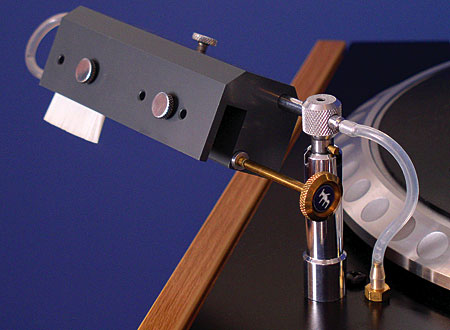
Because Keith Monks himself considered the wet-wash half of the equation just as important as the vacuum-dry half—and just as needful of consistency and repeatability—that chore was also automated. Virtually every Keith Monks RCM incorporates a system for dispensing cleaning fluid onto the record's surface: a hidden reservoir, a mechanical pump, some flexible plastic tubing, and a series of minuscule holes drilled into a plastic block, which itself holds the soft-bristled cleaning brush. During the wash cycle, the user spins a record on the RCM's high-torque platter, lowers the brush to the record's surface, depresses a plunger button enough times to coax sufficient fluid onto the record, and voil‡: scrubbing happens.
All of the current RCM products manufactured by Keith Monks Audio Works use that very system. But they almost weren't manufactured at all: Keith Monks passed away in 2005, after a relatively brief battle with cancer, and for a time it appeared that there would be no more KM RCMs, or even spare parts for existing stock. Finally—blessedly—Keith's son Jonathan, who spent a portion of his own career in audio engineering working alongside his father, took up the reins.
There have, of course, been changes. For one thing, the RCMs are now put together in a dedicated manufacturing facility on the Isle of Wight, just off the south coast of England. For another, Jonathan Monks has taken the rather bold step of expanding the line, to include new RCMs, new platter mats, new cleaning brushes, and, for the first time, Monks' own line of specially formulated cleaning fluids.
Just before Christmas, I received a sample of the new Keith Monks Omni RCM ($6495 in white, $6695 in English oak), which is designed to wash and dry 7" and 10" records along with 12" LPs. Certain design elements have been reworked for the Omni, most notably in the wet-wash system: On earlier Keith Monks RCMs, the fluid-dispensing holes incorporated into that plastic brush-block describe a line that's approximately 4" long—slightly more than the width of an LP's modulated portion. For the Omni, a thin metal plunger is also included, which the user can slide in or out of the block in an effort to close off some of those holes, in order to limit the physical range of fluid dispersal. That refinement, along with a brush-clamping system that makes it easier to swap the 4" brush for 2" and 3" ones—also included with the Omni—allows the user to wet-wash 45rpm singles and 10" shellacs without flooding the platter mat.
As to the latter, Jonathan Monks devised another welcome refinement: the Keith Monks PyraMat, which supports the record by means of several tiny "pyramids" molded into the neoprene itself. Those gentle nubs make it less likely that the clean side of a record will be recontaminated by dirt or excess fluid, the latter of which can now dribble harmlessly away. PyraMats are also keyed to the three different record sizes—the portion that supports the record is actually a higher tier than the rest of the mat—and, again, all three are supplied with the Omni, or available as accessories for use with other RCMs.
Fluid assets
Finally, there are three new Keith Monks cleaning fluids: discOvery 33/45 and discOvery 78, for vinyl and shellac, respectively; and discOvery BreakTheMold, an antifungal pre-wash intended for whatever hardcases seem to need it. Jonathan Monks says all three are made from the finest botanicals—just like your favorite gin—and are fully biodegradable.
Actually, there's one thing more: a brand-new owner's manual, which I daresay most would consider a great improvement over the old manual. (Come to think of it, was there an old one?) The new manual is thorough and helpful, although I encountered one discrepancy: The procedure for releasing the transit bolts that secure the suspended vacuum pump wasn't quite as described. Also, the manual could be made better still with the addition of a few good pictures. I'm told the latter are being worked on as I write.
Footnote 1: Keith Monks Audio Works, Units 3–9 Westcliff Park, Ventnore, Isle of Wight PO38 2YR, England. US Distributor: Keith Monks American Audio Works, 181 Prynnwood Road, Longmeadow, MA 01106-272. Tel: (413) 754-3313. Web: www.keithmonks-rcm.co.uk.
- Log in or register to post comments


